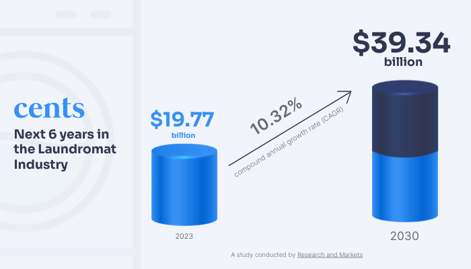The laundromat industry presents exciting laundromat business opportunities, thanks to rapid advancements in future laundry technology and continuous laundry innovation transforming operations. Keep reading to learn about the laundry industry’s massive growth potential, and what current and future laundromat owners stand to make with this juggernaut of a business opportunity.

Dive deeper with our white paper, "Grow, Manage & Understand Your Laundry Business." Gain expert insights and actionable strategies to not only keep pace but excel in the evolving market. Download now and transform the way you operate your laundromat today!
Laundromat Business Opportunities and Industry Growth Projections

A study conducted by Research and Markets forecasts an impressive global laundry market compound annual growth rate (CAGR) of 10.32% and is projected to reach $39.34 billion by 2030 from a valuation of $19.77 billion in 2023. This data comes from their January 2024 "Global Coin-operated Laundries Market" report, which specifically analyzes coin-operated washers and dryers in both commercial and residential applications across global markets.
That's significant growth for an established industry that is almost entirely owned and operated by mom & pop operators. This laundry market reporting spans across residential, commercial, self-service, and full-service laundry businesses, which means everyone can get their slice of the revenue pie.
Key Market Trends Fueling Laundromat Business Growth
The laundromat industry is experiencing a shift fueled by a constellation of market trends reshaping its landscape. As essential service providers, laundromats are capitalizing on socio-economic changes, technological advancements, and evolving consumer behaviors.
A Brief History of the Laundry Industry: From Coin-Operated to Future Laundry Technology
The laundry industry has experienced significant transformation over the years, marked by strategic developments and pivotal acquisitions.
-
Early 2000s to 2010s: The focus was primarily on expanding service capabilities and improving efficiency through technology. This period saw the proliferation of coin-operated laundromats being upgraded to card-operated facilities, enhancing customer convenience.
-
Mid-2010s to early 2020s: Technological advancements led to the integration of digital payment systems and online service bookings, reflecting broader trends in retail and services industries.
-
Recent developments: In recent years, there has been a trend towards non-competitive mergers where companies with complementary services join forces. These mergers aim to combine expertise in different niches of the laundry industry to enhance service delivery and expand market reach without directly competing against each other. A significant event was the acquisition of Laundroworks, a prominent player in laundry automation systems. This is part of a broader trend we’re seeing where larger companies absorb smaller, innovative firms to integrate advanced technologies and expand their service offerings.
Top trends driving laundromat growth
Here are the top trends driving the growth of the laundromat industry, illustrating why this sector is thriving in today's economy:
-
Increase in working-class population: The expansion of the working-class demographic worldwide has contributed significantly to the growth of coin-operated laundries. This population often relies on convenient and cost-effective laundry solutions provided by laundromats.
-
A drop in home ownership: Due to recessionary pressures in 2022-2023, fewer people are buying and owning homes. This has led to an expansion of laundromat services. Moreover, people cannot afford the repair, replacement, or purchase of new washers and dryers, so they are compelled to seek alternatives.
-
Less disposable household income: The most significant sector of the Laundromats industry comprises washer and dryer services, which operate through coin, card, or attendant-operated facilities. Demand has surged as more homeowners find less disposable income to purchase their appliances, primarily because of increased interest rates, which have increased household machines' costs.
-
Rising demand and technological advancements: There is a sustained increase in demand for laundry services, accompanied by the growth of cashless and self-service laundries. This trend is supported by technological advancements in the industry that make laundry services more accessible and efficient.
-
Significant financial growth: The global coin-operated laundries market has shown robust financial growth, with projections indicating continued expansion at a notable compound annual growth rate (CAGR).
-
Increase in service options: pickup and delivery, wash-and-fold, luxury cleaning services, all empower laundromat owners to provide a wider breadth of services and cater to more and more customers.
Future Laundry Technology: Innovations Shaping the Industry
The need for more profitable revenue, customer convenience, and operational efficiency have ushered in a new playing field for technology innovation in the laundromat. Some notable game changers include:
-
Mobile payments: A significant shift from traditional coin-operated machines to mobile payment options. This change offers convenience for customers and streamlines transactions, reducing the need for physical cash handling.
-
Remote management systems: These systems allow you to monitor and manage your operations remotely. This technology helps in tracking the performance of machines, managing supplies, and responding to customer needs in real-time.
-
Smart laundry machines: The integration of smart technology into laundry machines introduces features that enable automation, enhance energy efficiency, and allow for the customization of washing programs based on the characteristics of each load. These advancements improve the user experience and operational efficiency.
-
Advanced point-of-sale systems: Tailored for laundromats of any size or type, these systems are designed to meet the diverse operational needs, facilitating streamlined transactions and enhanced service management.
-
Order tracking and management: Enhance your pickup and delivery services with a digital POS system and order platform that ensures operational efficiency from intake to completion, simplifying the entire process.
-
Revenue growth tools: Utilize detailed performance metrics to optimize offerings and implement loyalty programs and promotions that attract repeat business.
-
Operational insights and reporting: Access real-time dashboards and detailed reports to gain critical insights into your business, enabling data-driven decision-making that enhances operational effectiveness.
These technologies and tools allow today’s laundromat owners to significantly enhance operational efficiency, improve customer satisfaction, and drive business growth through a more intimate, data driven look into their business.
Laundromat Business Opportunities: New Growth Avenues

The laundromat industry is ripe with opportunities for growth, especially for those serious about expansion and customer-centric solutions. As the laundromat market continues to evolve, entrepreneurs are looking to open their business to multiple locations and integrate advanced technology. While self-service laundromats are projected to continue to grow, there are opportunities to utilize those same assets, the commercial washing machines and dryers, to incorporate a service side of your laundromat business. By 2024, more and more laundromats are anticipated to diversify their income through untapped revenue streams, such as wash-and-dry services.
-
Expansion into multi-store ownership: Owners are increasingly recognizing the benefits of scaling their operations. Opening multiple locations allows owners to tap into new markets and streamline operations across all sites, enhancing overall profitability.
-
Integration of modern technology: Advanced technology is revolutionizing the laundromat industry. Laundromat software like Cents provide a full range of tools that help owners manage everything from self-service operations to full-service options, including laundry pickup and delivery. This technology simplifies daily management and allows owners to add services like wash-dry-fold, appealing to customers looking for convenience and creating new revenue opportunities.
Maximizing Laundromat Business Opportunities with Smart Growth Strategies
With no end to laundry industry growth in sight, here are some tips to differentiate your own laundromat from your competitors, so you can bolster your profit foothold for years to come!
-
Diversify service offerings: Broaden your range of services to include full-service options such as wash-dry-fold, dry cleaning, pickup and delivery, and specialized fabric care.
-
Embrace technology and automation: Invest in advanced laundry technology to enhance efficiency and customer experience. Implementing automated sorting systems, digital payment options, and online booking systems can streamline operations and improve service delivery.
-
Focus on sustainability: With increasing consumer awareness about environmental issues, adopting eco-friendly laundry practices can be a significant business advantage. Utilize energy-efficient machines, biodegradable detergents, and water recycling systems to reduce your environmental footprint.
-
Expand into niche markets: Explore niche markets by offering specialized services such as hypoallergenic laundering, pet bedding cleaning, sneaker cleaning, or sports gear laundering.
-
Leverage business intelligence: Use data analytics to gain insights into customer behavior, operational efficiency, and market trends, helping you to make informed decisions about expansion.
-
Build strategic partnerships: Form alliances with related businesses such as hotels, hospitals, or residential complexes that require regular laundry services. These partnerships can lead to steady contracts and a reliable source of income.
-
Invest in employee training: Making sure your staff is well-trained is one of the biggest factors in customer satisfaction. Invest in regular training programs to keep your team updated with the latest policies and customer service best practices.
-
Implement a marketing strategy: Develop a comprehensive laundromat marketing strategy that includes digital and traditional techniques, using social media, search engine optimization (SEO), and content marketing to reach a broader audience online.
By checking all these boxes, you’re sure to provide amazing value to a modern customer base. Investing in your business will not only allow you to meet your customers’ needs, but also increase profitability and secure your business as a leader in the future of laundry innovation and success.
Frequently Asked Questions
1. What is the U.S. laundry industry worth in 2024
There are about 29,500 laundromats in the United States. The U.S. laundromat industry generates approximately $5 billion in annual revenue.
2. What is the average startup cost for a laundromat?
The initial investment for opening a laundromat typically ranges from $200,000 to $500,000. This includes leasing a space, purchasing and installing washing machines and dryers, utility connections (especially water and drainage), renovation, and licensing fees.
3. How profitable is a laundromat business?
The profitability of a laundromat business can vary widely based on several factors, including location, operational efficiency, the quality of equipment, and customer service. However, laundromats are generally considered a stable and profitable business venture due to the consistent demand for laundry services.
4. What are the key factors for success in the laundromat business?
Success in the laundromat business is determined by several critical factors: choosing a strategic location with high population density and limited access to in-home laundry facilities, adopting modern technology such as cashless payment systems and laundry management software, maintaining high-quality, energy-efficient machines, ensuring a clean and comfortable environment, providing excellent customer service, offering diversified services like wash-and-fold and dry cleaning, implementing effective marketing strategies, optimizing operational efficiency, complying with local regulations and industry best practices, and engaging with the local community.
5. How much does it cost to maintain a laundromat?
Maintaining a laundromat involves several expenses. Equipment maintenance and repairs average at 1-2% of the equipment's purchase price annually. Utility costs (water, electricity, gas, sewage) run from $1,000 to over $5,000 monthly depending on local rates and usage. Rent or mortgage payments, insurance for equipment and liability, and supplies including cleaning materials and operational items are also recurring monthly expenses. Additional costs include vending machine upkeep, business licenses and permits, and miscellaneous expenses like pest control and security systems.
6. Is the laundromat industry competitive?
The laundromat industry presents a valuable opportunity for entrepreneurs, thanks to its sustainable demand and relatively low barriers to entry. While the industry is competitive, particularly in urban areas, this competition drives innovation and service quality, creating a market environment that is ripe for new business owners with fresh ideas.
7. What makes a laundromat an investment passive?
A laundromat is a passive investment largely because its operations can be highly automated, allowing minimal day-to-day involvement from the owner. Customers typically handle their own laundry tasks due to the self-service model, reducing the need for staffing. With features like automated payment systems and remote monitoring capabilities, laundromats can operate continuously with little oversight, generating steady cash flow.
8. What is the average return on investment (ROI) for a laundromat?
The average return on investment (ROI) for a laundromat typically ranges from 20% to 35%, which is relatively high compared to many other small businesses. Factors that significantly influence ROI include location, the efficiency of equipment, and the range of services offered, such as wash-and-fold or dry cleaning. Due to their high ROI, laundromats often have a short payback period, with many owners seeing a full return on their initial investment within 5 to 7 years.
Seizing Laundromat Business Opportunities: The Future of Laundry Innovation
The laundromat industry is evolving rapidly, creating unmatched business opportunities for entrepreneurs ready to embrace future laundry technology and laundry innovation. With advancements like smart laundromats, mobile payments, and automated management systems, laundromat owners can now operate more efficiently, attract more customers, and maximize profits.
If you're looking to future-proof your laundromat business, now is the time to invest in cutting-edge technology and automation. Cents provides a complete laundromat management platform, offering solutions for self-service, full-service, and pickup & delivery operations.
Contact Cents today to learn how our future laundry technology can streamline your operations, increase revenue, and enhance customer experience.

Dive deeper with our white paper, "Grow, Manage & Understand Your Laundry Business." Gain expert insights and actionable strategies to not only keep pace but excel in the evolving market. Download now and transform the way you operate your laundromat today!
.png?width=2196&height=2196&name=OS%20(1).png)

-3.png?width=224&height=213&name=Accelerate%20(2)-3.png)








.png?width=400&height=200&name=Thumbnail%20(3).png)